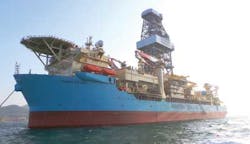P.2 ~ Drilling in Gulf of Mexico remains robust
View Article as Single page
Regulators are also forcing companies to take a more systemic approach to drilling safety. Instead of following a set of rules, companies are being required to develop drilling plans that prove they have taken appropriate steps to avoid blowouts. And those plans must be signed off on by a third-party consultant.
At least partly as a result, drilling costs in the GoM have increased dramatically over the last five years. The regulations set in place since Macondo require more expensive equipment, and have extended drilling periods on some deepwater wells to nine months, roughly 30% longer than before. Despite all this, increased demand in the Gulf and other offshore areas has driven up the rates on the advanced drilling rigs needed for deepwater jobs to more than $500,000 a day.
In recent weeks, a number of operators and contractors have updated their exploration and development efforts in the Gulf, or announced the start of new drilling campaigns.
In April, Stone Energy Corp. reported success on the deepwater Cardona South well in Mississippi Canyon block 29. The company said that the Cardona South well (MC 29 #5) encountered more than 275 ft (84 m) of net oil pay in three separate sections of the well.
The Cardona South well extends the productive zone of the Mississippi Canyon 29 TB-9 well to the adjacent fault block to the south and sets up a potential second and third well in the fault block. Plans are to flow the Cardona South well (and the previously announced Cardona discovery) to the Stone owned and operated Pompano platform, with first production expected in early 2015.
Production casing has been set and cemented in the Cardona South well and the subsea tree equipment will soon be put in place. The rig will then move back to the original Cardona well (MC 29 #4 well) to begin completion operations before returning to complete the Cardona South well. Separately, the original Cardona well was previously estimated to have approximately 84 ft (26 m) of net oil pay. After further evaluation, the estimated net oil pay for this well is now approximately 96 ft (29 m).
Also in April, Maersk Drilling reported that itsMaersk Valiant drillship had begun its voyage from Singapore to the Gulf, where it will commence a two-year contract with ConocoPhillips and Marathon Oil Corp. The estimated contract value with ConocoPhillips and Marathon for Maersk Valiant is $694 million including mobilization, but excluding cost escalation.
In May, Statoil announced that it had started drilling Martin, a high-impact prospect in the Gulf, on April 20. The company says that it considers Martin one of the top prospects in its global portfolio; and that, since acquiring the prospect in 2012, it has been able to advance it in 20 months, considerably faster than the normal maturation time.
Exxon Mobil is pursuing what is believed to be one of the largest deposits in the deepwater area, the Julia field. At a depth of more than 30,000 ft (9,144 m), Exxon is spending $4 billion, with production set to begin in 2016.
BP continues to focus on its deepwater fields in the Gulf, with a company-record 10 rigs operating there now. Officials say that the company will spend $10 billion over the next five years in thedeepwater Gulf, which amounts to about 10% of its worldwide exploration and production budget.
Likewise, Chevron has its Jack/St. Malo and Big Foot fields coming online this year and next. They are projected to eventually produce almost 170,000 b/d of oil — on par with daily oil production in Wyoming last year.
Analysts are projecting oil prices will drop close to $80 by the end of 2015 as large quantities of crude come online. That could put a dent in the domestic hydraulic fracturing boom, in which operators must constantly drill new wells to keep up with rapid declines in productivity.
But the same impact is not expected in the Gulf of Mexico. With billions of dollars invested and steadier productivity from deep Gulf wells, the oil companies have committed themselves for the long term.
About the Author
Bruce Beaubouef
Managing Editor
Bruce Beaubouef is Managing Editor for Offshore magazine. In that capacity, he plans and oversees content for the magazine; writes features on technologies and trends for the magazine; writes news updates for the website; creates and moderates topical webinars; and creates videos that focus on offshore oil and gas and renewable energies. Beaubouef has been in the oil and gas trade media for 25 years, starting out as Editor of Hart’s Pipeline Digest in 1998. From there, he went on to serve as Associate Editor for Pipe Line and Gas Industry for Gulf Publishing for four years before rejoining Hart Publications as Editor of PipeLine and Gas Technology in 2003. He joined Offshore magazine as Managing Editor in 2010, at that time owned by PennWell Corp. Beaubouef earned his Ph.D. at the University of Houston in 1997, and his dissertation was published in book form by Texas A&M University Press in September 2007 as The Strategic Petroleum Reserve: U.S. Energy Security and Oil Politics, 1975-2005.



